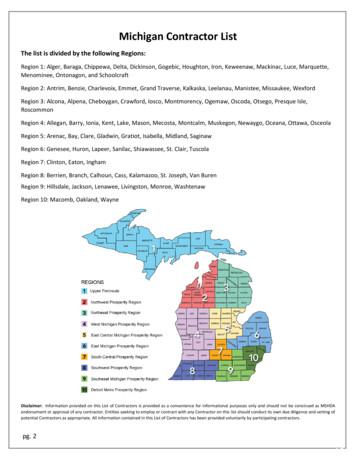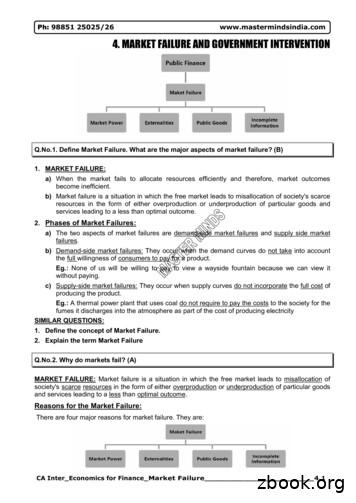Industrial: Overcoming Mechanical Failures In Industrial .
Industrial Technology:Overcoming Mechanical Failures in Industrial Horns and SoundersAbstractElectromechanical horns, sirens and other sounders have been integral fixtures in and aroundcommercial and industrial facilities for decades. These audible devices produce loud clear tones usedin a variety of applications within manufacturing facilities, schools, office buildings, and sporting arenasto name a few. However, the mechanical actuators used in these devices have certain limitations.Limitations include: Restricted duty cycle requiring the unit to be cycled on and off to prevent premature failure. They are prone to mechanical failure because of the rapidly moving parts. Higher drive current is necessary to move the mechanical actuator, and they have minimal toneflexibility and limited sound output adjustment.This paper will discuss several types of electromechanical horns and sirens as well as how theadvancements in electronic horns and sirens have overcome mechanical limitations or theirpredecessors while producing the same loud, rich, clear tones.Understanding the Current TechnologyThe following is a brief description of the types and functionality of the various signaling devices.Electromechanical SirenA traditional electromechanical siren utilizes a spinning rotor, effectively a fan, driven by an electricmotor inside of a stator. The stator is an enclosure with a series of holes or gaps located around theparameter (see figure 1 & 2). As the rotor spins it draws air in through the center of the device andforces it out through the gaps in the stator. This puffing or chopping of the air through the gapsproduces sound waves at a specific tone and at a given volume or sound pressure level (SPL). Thesize of the components, the rotor and stator, and the speed at which it spins; combined with theprojector that directs the sound waves produces a specific tone and volume. With the fixed size andspacing of the components the only common variable is the rotation speed of the rotor.
Industrial Technology:Overcoming Mechanical Failures in Industrial Horns and SoundersTherefore, the siren running continuously will produce a steady tone or continuous blast. If the drivemotor is alternated on and off varying the speed of the motor, a siren can produce a series of effectssuch as a wail, a slow rising and falling of the tone.As with any moving mechanical component, there are several possibilities for failure: The rotor and stator are vulnerable to intrusion of dirt or other environmental debris causingwear on the parts or possible unbalance. If the rotor spins out of balance, it often contacts the stator causing damage and ultimate failureof the device. Intrusion of water will cause the components to corrode or rust. The drive mechanism that spins the rotor is traditionally a standard electric motor. This type ofmotor typically has higher current draw and the inherent failure points of any electric motor.StatorStatorRotorRotorPlane used inFig 2 cutaway viewFig 1: Rotor and stator in a typical electromechanical sirenFig 2: Cutaway view of mechanism in Fig 1Electromechanical HornCommon electromechanical horns utilize a complex system of magnets, contacts, springs and adiaphragm all connected by a mechanical shaft (see figure 3 &4). The drive mechanism in this hornrapidly flexes a diaphragm back and forth, pushing the air in front of it and creating sound waves.Illustrated in the diagram below (Fig 3.1), when power is applied and the circuit is complete at thecontacts, power is transferred to an electromagnet (Fig 3.2). This energizes the magnet and draws the2 2016 Federal Signal Corporation. All rights reserved.
Industrial Technology:Overcoming Mechanical Failures in Industrial Horns and Soundersarmature down toward the magnet, flexing the diaphragm via the shaft (Fig 4.1). At the same time theelectrical contact is broken (Fig 4.2), de-energizing the electromagnet and allowing the internal springto return the shaft to the starting position. The electronic contact is reconnected (Fig 3.1) and the cyclebegins again. This cycle can repeat over 300 times per second.3.1 Electrical Contacts(closed position)4.2 Electrical Contacts(open position)Armature3.2 Electromagnet4.1 Diaphragm(flexed)DiaphragmFig 3: Electromechanical horn mechanism in anunpowered stateFig 4: Electromechanical horn mechanism in a poweredstate (armature has reached lower travel limit)The repeated flexing of the diaphragm pushes against the air in front of the diaphragm creating pulsingair waves thus producing the sound waves. Many factors affect the tone and volume (SPL) of anelectromechanical horn. These include the diameter, thickness and materials of the diaphragm, andthe shape and length of the horn/projector. The frequency at which the diaphragm flexes significantlyaffects the final output. Similar to the electromechanical siren, horns are typically a single tone andsingle SPL per device. Variation in the signaling capability can be achieved through coded blasts, aseries of blasts followed by periods of silence that is similar in concept to Morse code. The complicatednature of the mechanism contributes to a limited duty cycle and potential mechanical failure points thatinclude corroded contact points, cracked diaphragms and broken springs.Electronic Horn & SirenThe new Federal Signal eHorn and eSiren overcomes all the issues inherent to the electromechanicaldevices by eliminating a required duty cycle, significantly lower operating current, minimizingmechanical vulnerability and significantly expanding the signal’s flexibility through multiple tones andvolume settings. These new electronic horns (Fig 5) and sirens utilizes a patent pendingmicroprocessor based tone generating technology to generate a frequency that is transmitted to anelectronic speaker coil. The coil stimulates the robust speaker diaphragm, causing it to vibrate andcreate and transmit sound waves in the air and through the reentrant horn. This produces the desiredsound waves that correspond to a desired tone.3 2016 Federal Signal Corporation. All rights reserved.
Industrial Technology:Overcoming Mechanical Failures in Industrial Horns and SoundersThis robust proven diaphragm is the only moving part of this device, eliminating a required duty cycleand increasing the horn’s reliability. With no electric motors or electromagnet actuator required to drivethe diaphragm, the new Federal Signal eHorn and eSiren require only 0.03 to 3.3 amps depending onthe model and operating voltage.Re-enterant horn sound pathSpeaker driverFig 5: Electronic Horn and Siren utilizes speaker driver and reentrant hornFederal Signal’s eHorn and eSiren are equipped with two onboard field selectable tones. The eHornreplicates the standard Federal Signal 52 or 55/56 horns with three selectable volume outputs rangingfrom 100 to 117 dB, depending on tone and operating voltage. The eSiren replicates the traditionalFederal Signal Model A or L siren. Additionally, the eSiren features three selectable volume outputsranging from 104 to 115 dB, depending on the tone selected and operating voltage.The new eHorn and eSiren are UL and cUL listed and carry the UL Marine rating. Additional benefits ofthe Federal Signal eHorn and eSiren include corrosion resistant glass reinforced polycarbonate housingthat provides a Type 4X, IP66 enclosure. The stainless steel mounting brackets and hardware are bothdurable and corrosion resistant, as well as, offer a variety of mounting options. These new electronicsignaling devices are suited for indoor and outdoor applications.The Federal Signal eHorn and eSiren devices are more reliable, flexible and durable. The use of thepatent pending sound generation technology paired with time tested components come together to4 2016 Federal Signal Corporation. All rights reserved.
Industrial Technology:Overcoming Mechanical Failures in Industrial Horns and Soundersproduce a superior product. By eliminating moving parts, Federal Signal has produced a durable andreliable signal device.The advanced electronics provide greater flexibility of the device by offering multiple field selectabletones and volume settings in a single unit. The advance materials used for the housing and time testedstainless steel brackets and hardware allow this equipment to function reliably in an array of polluted,damaging or corrosive environments. The eHorn and eSiren provide a superior solution in a widevariety of industrial applications.For more information visit the Federal Signal website, http://www.federalsignal-indust.com/5 2016 Federal Signal Corporation. All rights reserved.
Industrial Technology: Overcoming Mechanical Failures in Industrial Horns and Sounders . Abstract . Electromechanical horns, sirens and other sounders have been integral fixtures in and around commercial and industrial facilities for dec
Demand-side mark et failures happen when de-mand curves do not reflect consumers' full willing-ness to pay for a good or service. Suppl y-side market failures occur when supply curves do not reflect the full cost of producing a good or service. Demand-Side Market Failures Demand-side market failures arise because it is impossible
Mechanical Contractor Redmon Heating & Cooling Grandville (616) 534-9330 Mechanical Contractor D.K.S. Mechanical, Inc. Marne (616) 677-6001 Mechanical Contractor AirFlow Mechanical Services LLC Wyoming (616) 752-0320 Mechanical Contractor Van Antwerp's Mechanical, Inc. Holland (616) 772-1112 Mechanical Contractor Grand Rapids Heating and .
13.29 % failures were Class IV, 12.65 % failures were identified as class II, 12.02 % failures as class V and 5.69 % failures were categorized in class I failure. Conclusion: Though earlier literature reported caries as the most
a) The two aspects of market failures are demand-side market failures and supply side market failures. b) Demand-side market failures: They occur when the demand curves do not take into account the full willingness of consumers to pay for a product. Eg.: None of us will be willing to pay to view a wayside fountain because we can view it without .
Coiled Tubing Bias Welds Recent Failures Trend October 29 th, 2014 ICoTA Roundtable, Calgary, Canada Tomas Padron, Coiled Tubing Research and Engineering (CTRE) Bias Weld Failures - Outline . Great Yarmouth P2216 3 2014 ICoTA Roundtable - Bias Weld Failures 4.
Overcoming barriers to the positive development and engagement of ethno-racial minority youth in Canada. Page 1 1. INTRODUCTION This paper explores the dynamics behind and ways of overcoming barriers to the community, school, and civic participation and engagement of immigrant and Canadian-born ethno-racial minority youth
A framework for Overcoming Poverty and Economic Injustice in Africa is a result of the concerted efforts of churches of the communion of the . gender inequality, economic exploitation at all levels, undemocratic institutions and environmental . 6 A Framework for Overcoming Poverty and Eco
The American Revolution Part One: The events leading up the Revolutionary War (1750 – 1775) Background Historically speaking, right now “we” are British. The Colonies are an extension of Britain, so we share their government, their identity, their pride, and also their enemies. There is NO United States of America. Taunton Flag, flown by colonists to show unity with the British crown .























